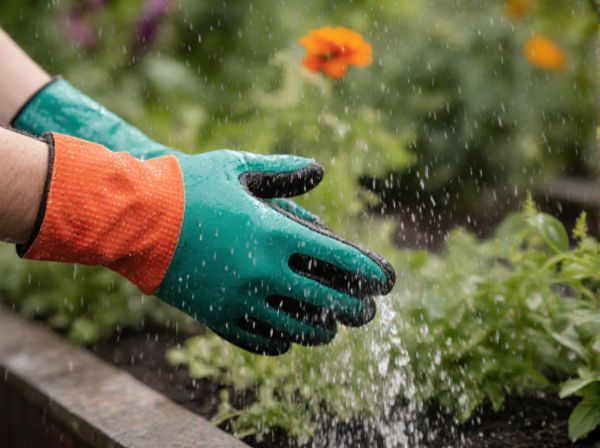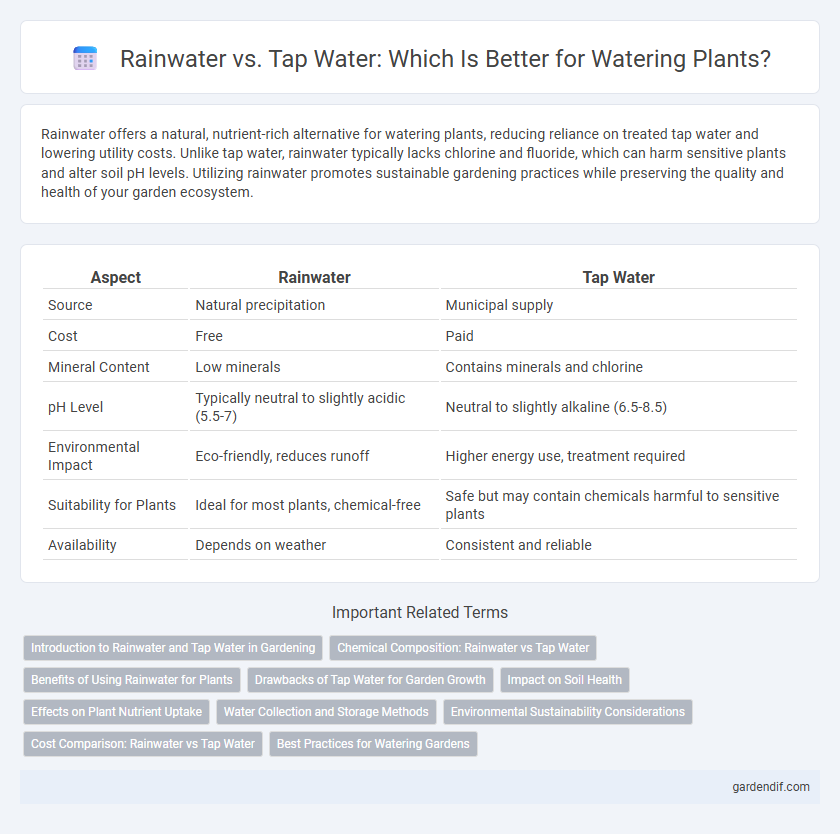
Rainwater vs Tap water Illustration
Rainwater offers a natural, nutrient-rich alternative for watering plants, reducing reliance on treated tap water and lowering utility costs. Unlike tap water, rainwater typically lacks chlorine and fluoride, which can harm sensitive plants and alter soil pH levels. Utilizing rainwater promotes sustainable gardening practices while preserving the quality and health of your garden ecosystem.
Table of Comparison
| Aspect | Rainwater | Tap Water |
|---|---|---|
| Source | Natural precipitation | Municipal supply |
| Cost | Free | Paid |
| Mineral Content | Low minerals | Contains minerals and chlorine |
| pH Level | Typically neutral to slightly acidic (5.5-7) | Neutral to slightly alkaline (6.5-8.5) |
| Environmental Impact | Eco-friendly, reduces runoff | Higher energy use, treatment required |
| Suitability for Plants | Ideal for most plants, chemical-free | Safe but may contain chemicals harmful to sensitive plants |
| Availability | Depends on weather | Consistent and reliable |
Introduction to Rainwater and Tap Water in Gardening
Rainwater is naturally soft and free from chemicals like chlorine and fluoride, making it ideal for watering plants without altering soil pH. Tap water, treated for human consumption, often contains minerals and disinfectants that can accumulate in soil and potentially harm sensitive plants over time. Understanding the chemical composition and environmental impact of each water source can help gardeners optimize plant health and water efficiency.
Chemical Composition: Rainwater vs Tap Water
Rainwater typically contains fewer dissolved minerals and chemicals, making it softer and free from chlorine, fluoride, and heavy metals commonly found in tap water. Tap water is treated with disinfectants like chlorine to ensure safety but often carries additives and higher concentrations of calcium, magnesium, and other minerals. Understanding these differences in chemical composition is essential for optimizing plant hydration and soil health.
Benefits of Using Rainwater for Plants
Rainwater provides plants with naturally soft, chlorine-free water that enhances nutrient absorption and supports healthier growth. Its slightly acidic pH helps dissolve essential minerals in the soil, promoting better root development and vibrant foliage. Utilizing rainwater also conserves tap water resources and reduces the exposure of plants to harmful chemicals commonly found in municipal water supplies.
Drawbacks of Tap Water for Garden Growth
Tap water often contains high levels of chlorine, fluoride, and salts that can harm sensitive plants and disrupt soil microbiomes essential for healthy garden growth. The minerals and chemicals in tap water can lead to soil alkalinity imbalances, reducing nutrient availability and inhibiting root development. Over time, continued use of tap water may cause leaf burn, stunted growth, and decreased plant vitality compared to rainwater's natural purity.
Impact on Soil Health
Rainwater contains fewer chemicals and salts compared to tap water, making it gentler on soil microbial life and promoting healthier soil structure. Tap water often carries chlorine, fluoride, and other additives that can accumulate in the soil, potentially harming beneficial microorganisms and reducing soil fertility over time. Using rainwater for irrigation enhances soil aeration and nutrient retention, supporting sustainable plant growth and long-term soil health.
Effects on Plant Nutrient Uptake
Rainwater contains fewer salts and chemicals compared to tap water, promoting more efficient nutrient absorption in plant roots. Tap water often has elevated levels of chlorine and fluoride that can alter soil pH and inhibit the uptake of essential minerals like calcium and magnesium. Using rainwater enhances soil microbial activity, which in turn supports healthier nutrient cycling and improved plant growth.
Water Collection and Storage Methods
Rainwater collection utilizes rooftops, gutters, and storage tanks, capturing natural precipitation to reduce reliance on municipal supplies. Tap water storage often involves basic containers or pressure tanks connected directly to the water system, requiring minimal collection infrastructure. Rainwater harvesting systems typically include filtration and sedimentation stages to ensure water quality before storage, whereas tap water is pre-treated by utilities but may require additional on-site filtration.
Environmental Sustainability Considerations
Rainwater harvesting reduces reliance on municipal tap water, conserving valuable drinking water resources and lowering energy consumption associated with water treatment and distribution. Utilizing rainwater for irrigation minimizes runoff and erosion, promoting groundwater recharge and reducing the environmental impact of stormwater management. Tap water, often treated with chemicals and transported over long distances, carries a larger carbon footprint compared to locally sourced rainwater, making rainwater a more sustainable option for watering plants and gardens.
Cost Comparison: Rainwater vs Tap Water
Harvesting rainwater for irrigation significantly reduces monthly water bills compared to relying solely on tap water, especially in regions with high municipal water rates. Initial investment in rainwater harvesting systems can be offset by long-term savings, as tap water usage for gardening often incurs substantial cumulative costs. Utilizing rainwater decreases dependence on treated water, leading to both economic and environmental benefits.
Best Practices for Watering Gardens
Rainwater is ideal for garden watering due to its natural softness and lack of chemicals, promoting healthier soil and plants. Tap water often contains chlorine and fluoride, which can accumulate and negatively affect sensitive plants over time. Using rainwater collection systems alongside occasional tap water supplementation ensures efficient hydration while preserving soil quality and plant health.
Rainwater vs Tap water Infographic

 gardendif.com
gardendif.com